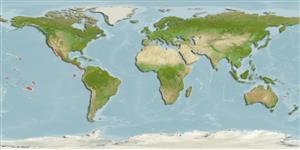Teleostei (teleosts) >
Ovalentaria/misc (Various families in series Ovalentaria) >
Opistognathidae (Jawfishes)
Etymology: Lonchopisthus: Greek, logche = lance + Greek, opisthe = behind (Ref. 45335).
Environment: milieu / climate zone / depth range / distribution range
Ecology
Marine; demersal; depth range 10 - 40 m (Ref. 55763). Tropical
Eastern Central Pacific: Gulf of California.
Size / Weight / Age
Maturity: Lm ? range ? - ? cm
Max length : 30.0 cm TL male/unsexed; (Ref. 11482); common length : 20.0 cm TL male/unsexed; (Ref. 55763)
Short description
Identification keys | Morphology | Morphometrics
Dorsal spines (total): 11; Dorsal soft rays (total): 17 - 19; Anal spines: 3; Anal soft rays: 17 - 18. Body somewhat elongated, narrowing posteriorly; head and mouth large; caudal fin lanceolate and much longer than total length of head; head and body cinnamon or cream with diffuse bluish spots. Operculum with an intense blue spot; median fins violet (Ref. 55763).
Most specimens taken from flat sandy bottoms. Feeds on benthic and planktonic invertebrates.
Life cycle and mating behavior
Maturity | Reproduction | Spawning | Eggs | Fecundity | Larvae
Allen, G.R. and D.R. Robertson, 1994. Fishes of the tropical eastern Pacific. University of Hawaii Press, Honolulu. 332 p. (Ref. 11482)
IUCN Red List Status (Ref. 130435: Version 2024-1)
Threat to humans
Harmless
Human uses
Fisheries: bycatch
Tools
Special reports
Download XML
Internet sources
Estimates based on models
Preferred temperature (Ref.
123201): 21.7 - 28.2, mean 25.6 °C (based on 28 cells).
Phylogenetic diversity index (Ref.
82804): PD
50 = 0.5312 [Uniqueness, from 0.5 = low to 2.0 = high].
Bayesian length-weight: a=0.00389 (0.00180 - 0.00842), b=3.12 (2.94 - 3.30), in cm total length, based on all LWR estimates for this body shape (Ref.
93245).
Trophic level (Ref.
69278): 3.5 ±0.41 se; based on food items.
Fishing Vulnerability (Ref.
59153): Low vulnerability (20 of 100).
